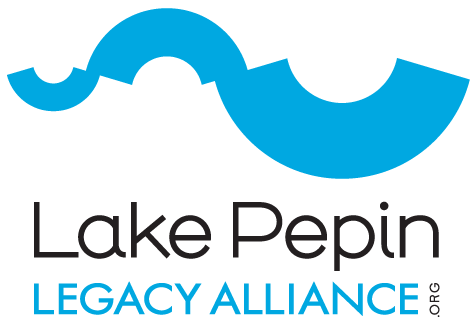Sediment plume in Lake Pepin.
There has been a flurry of news around Lake Pepin restoration recently—and for good reason. The Lessard-Sam’s Outdoor Heritage Council (LSOHC) recommended Lake Pepin Legacy Alliance’s (LPLA) proposal of $750,000 for Lake Pepin habitat restoration to the Minnesota legislature. Soon after, we learned that Lake Pepin was selected for a federal pilot program (Section 1122) to bolster and expand the scope of restoration.
LPLA has been receiving the same common sense questions about restoration. Hopefully, we can provide some valuable insight into:
1. Why do a restoration project in Upper Lake Pepin when the underlying problem is upstream sediment loads?
2. Why haul sediment from Lower Lake Pepin when there is excess sediment already in Upper Lake Pepin?
1. Why do a restoration project in Lake Pepin when the underlying problem is upstream sediment loads?
In Prescott, WI at the confluence of the St. Croix and Upper Mississippi River. (Photo Credit: Jonathan Sherlock)
If you’re asking this question, then your intuition is in the right place. Sediment reduction is the only sustainable option, but local restoration is necessary to maintain current uses, reverse ecological degradation, and redirect sediment input to have less overall impact.
Upstream sediment reduction is painstakingly slow and failing to meet interim goals. After 6 years of upstream mitigation efforts (2010-2016), actual sediment reduction is less than 1%. The Minnesota Pollution Control Agency (MPCA) is working on a revised sediment reduction plan with new goals, but in the meantime, conditions in Lake Pepin are getting worse.
If we don’t take action, Lake Pepin will slowly deteriorate, impacts may become irreversible, and the option of restoration will likely become cost-prohibitive. Restoration is a long-term LPLA strategy to protect critical areas that have a high ecological and/or human value.
Also Read: LPLA’S Top 5 Reasons for Restoration
2. Why haul sediment from Lower Lake Pepin when there is excess sediment already in Upper Lake Pepin?
First, suitable material. Not all dredged material is the same. The restoration project will include dredging areas in Upper Lake Pepin to increase depths and create habitat. The dredged material from the project area will be used to cap the new land features, but is too fine to be used for the actual construction. The dredged material from the Lower Lake Pepin is more course and therefore more suitable for actual construction.
Second, program constraints. LPLA was able to spearhead this project using Section 204 Beneficial Use of Dredge Material, which is designed to use dredge material for ecological benefits. For the project to exist, we essentially need to give new life to material already being dredged. LPLA worked with MN Audubon to find a way to make restoration possible—this was the route that worked.
That said, the Section 1122 Pilot Program, that the WI DNR and LPLA applied for together, will direct more federal dollars to the project and expand the scope to include social and economic benefits. This news was just released and we don't yet know exactly how it will be used for the project, but are confident that it will include dredging the Bay City harbor and improving local access to the lake.
Also Read: How LPLA Built a Road to Restoration (coming soon)










